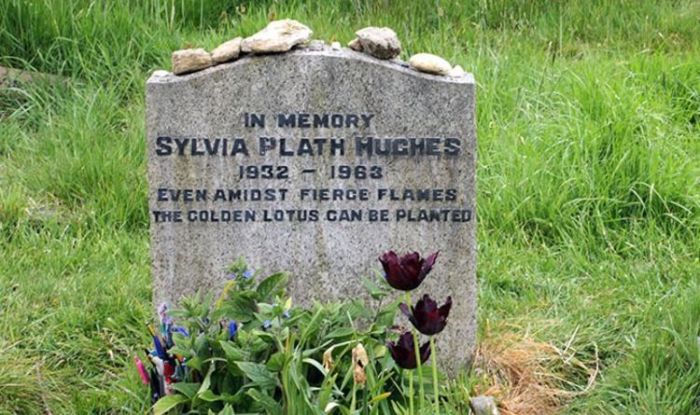Sylvia plath the manor garden – Sylvia Plath’s Manor Garden: A Literary and Personal Sanctuary takes readers on a captivating journey through the life and work of one of the most influential poets of the 20th century. This exploration delves into the profound influence of the Manor Garden on Plath’s poetry, revealing the garden’s significance as a source of inspiration, healing, and renewal.
Throughout her life, Sylvia Plath’s experiences, particularly those connected to the Manor Garden, deeply shaped her writing. Her poetry is renowned for its exploration of themes such as love, loss, and mental illness, themes that are often interwoven with vivid imagery of the garden’s natural beauty and symbolism.
Sylvia Plath’s Life and Poetry

Sylvia Plath’s life experiences profoundly shaped her poetry, particularly as it relates to the Manor Garden. Her troubled childhood, marked by her father’s early death and her mother’s mental illness, instilled in her a deep sense of loss and abandonment.
These experiences later manifested in her poetry as themes of grief, isolation, and the search for identity.
Sylvia Plath’s manor garden, with its lush greenery, inspires contemplation. The young ferns, like the seven little words that define them, symbolize hope and resilience. As we wander through the garden, their delicate fronds remind us of the beauty that can emerge from adversity, just as Plath’s writing continues to inspire generations.
Major Themes and Motifs
Plath’s poetry explores various major themes and motifs, including:
- Love and Loss:Plath’s experiences with love and loss are central to her poetry. She writes about the intensity of romantic love, the pain of heartbreak, and the profound grief that accompanies loss.
- Mental Illness:Plath’s own struggles with mental illness, particularly depression, are reflected in her poetry. She writes about the darkness, despair, and isolation that can accompany mental illness.
- Nature and the Supernatural:Plath finds solace in the natural world, often using imagery from nature to express her emotions. She also explores themes of the supernatural and the occult, which reflect her interest in the unknown.
The Manor Garden: Setting and Symbolism

Sylvia Plath’s “The Manor Garden” depicts a garden with lush vegetation and an oppressive atmosphere. It is characterized by overgrown paths, tangled vines, and decaying flowers, creating a sense of neglect and decay.
Physical Characteristics and Atmosphere
The garden is described as “a wilderness of weeds” with “rank grasses” and “tangled vines.” The flowers are “fading” and “rotting,” and the air is heavy with the scent of decay. The garden’s paths are “overgrown” and “hidden,” suggesting a sense of abandonment and neglect.
Symbolism
The Manor Garden symbolizes the subconscious mind, where hidden thoughts and emotions reside. The overgrown vegetation represents the wild, untamed nature of the subconscious, while the decaying flowers symbolize the repressed and forgotten aspects of the self.
The garden’s oppressive atmosphere reflects the psychological distress experienced by Plath’s persona. The decay and neglect symbolize the persona’s feelings of isolation, loneliness, and despair.
The garden also symbolizes nature’s power to both create and destroy. The lush vegetation represents the potential for growth and renewal, while the decay symbolizes the inevitability of death and destruction.
The Garden as a Source of Inspiration

The Manor Garden, with its vibrant colors, lush vegetation, and serene atmosphere, served as a rich source of inspiration for Sylvia Plath’s writing. The garden’s imagery and symbolism permeate her poetry, contributing significantly to the depth and impact of her work.
The Garden as a Symbol of Life and Death
The garden’s contrasting elements of beauty and decay provided Plath with a powerful metaphor for the cycle of life and death. In “The Manor Garden,” the flowers bloom with “a murderous splendor,” suggesting the delicate balance between creation and destruction.
The poem’s imagery of “red poppies” and “black bees” further emphasizes the co-existence of life and death within the garden.
The Garden as a Sanctuary
Amidst the turmoil of her personal life, Plath found solace and escape in the Manor Garden. In “Wintering,” the garden becomes a refuge where she seeks “some peace” and “a world of numbed flesh.” The poem’s imagery of “white stones” and “cold” conveys the garden’s ability to provide a sense of tranquility and respite.
The Garden as a Catalyst for Imagination, Sylvia plath the manor garden
The garden’s rich sensory experiences stimulated Plath’s imagination and inspired her to explore themes of nature, femininity, and the human condition. In “Poppies in July,” the garden’s “purple cups” and “green stalks” evoke a sense of abundance and growth. The poem’s imagery of “seeds” and “petals” suggests the potential for new life and renewal.
The Garden as a Place of Healing and Renewal: Sylvia Plath The Manor Garden

In the depths of her emotional turmoil, Sylvia Plath found solace and renewal within the Manor Garden. It became her sanctuary, a place where she could retreat from the overwhelming darkness that plagued her mind. Through her connection with nature, she sought to mend her broken spirit and find a glimmer of hope amidst the despair.
The garden provided Plath with a sense of belonging and purpose. She meticulously tended to the plants, finding solace in the simple act of nurturing life. The vibrant colors and delicate fragrances of the flowers lifted her spirits, reminding her of the beauty that still existed in the world.
The garden became a symbol of hope, a place where she could escape the confines of her own tormented thoughts and find a sense of peace.
Connection to Nature
Plath’s deep connection to nature is evident throughout her poetry. She saw the natural world as a reflection of her own inner turmoil, a mirror in which she could explore her emotions and find solace. The garden became a microcosm of her psyche, a place where she could confront her fears and seek healing.
In the poem “The Manor Garden,” Plath writes:
“I have eaten the plums that were in the iceboxand which you were probably saving for breakfast. Forgive me, they were delicious, so sweet and so cold.”
Through the act of consuming the plums, Plath symbolically devours the beauty of the garden, taking it into herself and finding nourishment for her weary soul. The act of eating the plums is a metaphor for her desire to absorb the healing power of nature and to make it a part of herself.
Source of Solace
The garden was more than just a physical space for Plath; it was a refuge where she could escape the pain and loneliness that haunted her. In the garden, she found solace and a sense of belonging. The flowers and plants became her confidants, witnesses to her deepest thoughts and emotions.
In the poem “Elm,” Plath writes:
“I know the bottom, she says. I know it with my great tap root:It is what you fear. I have been there, and I will be there again If you do not let me in.”
The elm tree in the garden becomes a symbol of strength and resilience, a reminder that even in the darkest of times, there is hope for renewal and growth. Plath’s connection to the elm tree represents her own desire to overcome her struggles and find a path towards healing.
The Garden in Contemporary Culture

Sylvia Plath’s Manor Garden continues to inspire and influence contemporary literature, art, and popular culture. Its haunting beauty and symbolism have resonated with artists and writers who have interpreted and reinterpreted its significance in their own works.
Literary Influences
Plath’s garden has been the subject of numerous poems, novels, and short stories. Poets such as Anne Sexton and Robert Lowell have written about the garden, exploring its themes of loss, grief, and renewal. Novelists like Margaret Atwood and Joyce Carol Oates have incorporated the garden into their works, using it as a setting for psychological and emotional exploration.
Artistic Interpretations
The garden has also inspired visual artists. Photographers like Sally Mann and Nan Goldin have captured its ethereal beauty, while painters like Peter Doig and Marlene Dumas have used it as a source of inspiration for their own works. The garden’s lush vegetation, vibrant colors, and intricate patterns have provided a rich canvas for artistic expression.
Popular Culture References
The garden has also found its way into popular culture. It has been featured in films such as “Sylvia” (2003) and “The Bell Jar” (1979), as well as television shows like “American Horror Story: Asylum” (2012). The garden’s symbolism and imagery have been used in fashion, music, and advertising, becoming a recognizable and iconic symbol of Plath’s life and work.
Frequently Asked Questions
What is the significance of the Manor Garden in Sylvia Plath’s life and poetry?
The Manor Garden served as a source of inspiration, healing, and renewal for Plath, providing her with a connection to nature and a refuge during times of emotional distress.
How does the garden’s symbolism contribute to Plath’s poetry?
The garden’s imagery evokes associations with nature, fertility, and the subconscious, enriching the depth and meaning of Plath’s work.
In what ways did the Manor Garden inspire Plath’s writing?
The garden’s beauty and symbolism provided Plath with a rich source of imagery and themes, inspiring many of her most notable poems.


